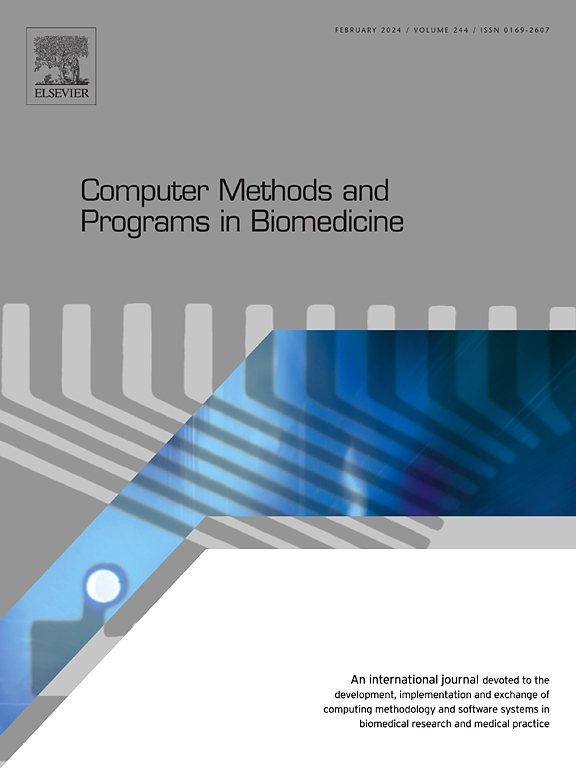基于机器学习的老年神经危重症患者28天死亡率预测模型
IF 4.9
2区 医学
Q1 COMPUTER SCIENCE, INTERDISCIPLINARY APPLICATIONS
引用次数: 0
摘要
背景:老年神经重症患者的人数不断增加,这凸显了对有效预后预测工具的需求。本研究旨在开发和验证用于预测重症监护病房(ICU)28 天死亡率的机器学习(ML)模型:数据提取自重症监护医学信息市场IV(MIMIC-IV)数据库,主要针对重症监护病房住院时间≥24小时的老年神经重症患者。我们使用拉索回归分析了 58 个变量,包括人口统计学、生命体征、药物、实验室结果、合并症和医疗评分,以确定 28 天死亡率的预测因素。对七种 ML 算法进行了评估,并利用贵州医科大学附属医院的数据对最佳模型进行了验证。对数秩检验用于评估 Kaplan-Meier 曲线的生存率差异。夏普利加法解释(SHAP)用于解释最佳模型,而亚组分析则确定了不同人群中模型性能的差异:研究纳入了 1,773 名老年神经重症患者,28 天死亡率为 28.6%。轻梯度提升机(LightGBM)的表现优于其他模型,内部验证的曲线下面积(AUC)为0.896,外部验证的曲线下面积(AUC)为0.812。Kaplan-Meier 分析表明,LightGBM 预测得分越高,生存概率越低。通过 SHAP 分析确定的关键预测因子包括动脉二氧化碳分压(PaCO2)、急性生理学和慢性健康评估 II(APACHE II)、白细胞计数、年龄和乳酸。LightGBM 模型在不同亚组中表现出一致的性能:LightGBM模型能有效预测老年神经重症患者28天内的死亡风险,有助于临床医生进行管理和资源分配。该模型在不同亚组中的可靠表现突显了其临床实用性。本文章由计算机程序翻译,如有差异,请以英文原文为准。
Machine learning-based 28-day mortality prediction model for elderly neurocritically Ill patients
Background
The growing population of elderly neurocritically ill patients highlights the need for effective prognosis prediction tools. This study aims to develop and validate machine learning (ML) models for predicting 28-day mortality in intensive care units (ICUs).
Methods
Data were extracted from the Medical Information Mart for Intensive Care IV(MIMIC-IV) database, focusing on elderly neurocritical ill patients with ICU stays ≥ 24 h. The cohort was split into 70 % for training and 30 % for internal validation. We analyzed 58 variables, including demographics, vital signs, medications, lab results, comorbidities, and medical scores, using Lasso regression to identify predictors of 28-day mortality. Seven ML algorithms were evaluated, and the best model was validated with data from Guizhou Medical University Affiliated Hospital. A log-rank test was used to assess survival differences in Kaplan-Meier curves. Shapley Additive Explanations (SHAP) were used to interpret the best model, while subgroup analysis identified variations in model performance across different populations.
Results
The study included 1,773 elderly neurocritically ill patients, with a 28-day mortality rate of 28.6 %. The Light Gradient Boosting Machine (LightGBM) outperformed other models, achieving an area under the curve (AUC) of 0.896 in internal validation and 0.812 in external validation. Kaplan-Meier analysis showed that higher LightGBM prediction scores correlated with lower survival probabilities. Key predictors identified through SHAP analysis included partial pressure of arterial carbon dioxide (PaCO2), Acute physiology and chronic health evaluation II (APACHE II), white blood cell count, age, and lactate. The LightGBM model demonstrated consistent performance across various subgroups.
Conclusions
The LightGBM model effectively predicts 28-day mortality risk in elderly neurocritically ill patients, aiding clinicians in management and resource allocation. Its reliable performance across diverse subgroups underscores its clinical utility.
求助全文
通过发布文献求助,成功后即可免费获取论文全文。
去求助
来源期刊

Computer methods and programs in biomedicine
工程技术-工程:生物医学
CiteScore
12.30
自引率
6.60%
发文量
601
审稿时长
135 days
期刊介绍:
To encourage the development of formal computing methods, and their application in biomedical research and medical practice, by illustration of fundamental principles in biomedical informatics research; to stimulate basic research into application software design; to report the state of research of biomedical information processing projects; to report new computer methodologies applied in biomedical areas; the eventual distribution of demonstrable software to avoid duplication of effort; to provide a forum for discussion and improvement of existing software; to optimize contact between national organizations and regional user groups by promoting an international exchange of information on formal methods, standards and software in biomedicine.
Computer Methods and Programs in Biomedicine covers computing methodology and software systems derived from computing science for implementation in all aspects of biomedical research and medical practice. It is designed to serve: biochemists; biologists; geneticists; immunologists; neuroscientists; pharmacologists; toxicologists; clinicians; epidemiologists; psychiatrists; psychologists; cardiologists; chemists; (radio)physicists; computer scientists; programmers and systems analysts; biomedical, clinical, electrical and other engineers; teachers of medical informatics and users of educational software.
 求助内容:
求助内容: 应助结果提醒方式:
应助结果提醒方式:


